
Pool of Radiance is a role-playing video game developed and published by Strategic Simulations, Inc (SSI) in 1988. It was the first adaptation of TSR's Advanced Dungeons & Dragons (AD&D) fantasy role-playing game for home computers, becoming the first episode in a four-part series of D&D computer adventure games. The other games in the "Gold Box" series used the game engine pioneered in Pool of Radiance, as did later D&D titles such as the Neverwinter Nights online game. Pool of Radiance takes place in the Forgotten Realms fantasy setting, with the action centered in and around the port city of Phlan.

David Lance Arneson was an American game designer best known for co-developing the first published role-playing game (RPG), Dungeons & Dragons, with Gary Gygax, in the early 1970s. Arneson's early work was fundamental to the role-playing game (RPG) genre, pioneering devices now considered to be archetypical, such as cooperative play to develop a storyline instead of individual competitive play to "win" and adventuring in dungeon, town, and wilderness settings as presented by a neutral judge who doubles as the voice and consciousness of all characters aside from the player characters.
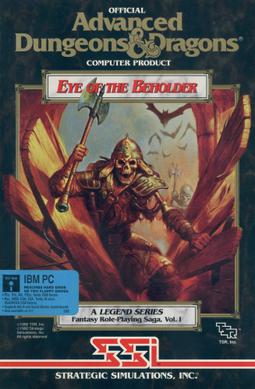
Eye of the Beholder is a role-playing video game for personal computers and video game consoles developed by Westwood Associates. It was published by Strategic Simulations, Inc. in 1991, for the MS-DOS operating system and later ported to the Amiga, the Sega CD and the SNES. The Sega CD version features a soundtrack composed by Yuzo Koshiro and Motohiro Kawashima. A port to the Atari Lynx handheld was developed by NuFX in 1993, but was not released. In 2002, an adaptation of the same name was developed by Pronto Games for the Game Boy Advance.

Wizardry II: The Knight of Diamonds is the second game in the Wizardry series of role-playing video games. It was published in 1982 by Sir-Tech.

Curse of the Azure Bonds is a role-playing video game developed and published by Strategic Simulations in 1989. It is the second in a four-part series of Forgotten Realms Advanced Dungeons & Dragons Gold Box games, continuing the events of Pool of Radiance.

The Fool's Errand is a 1987 computer game by Cliff Johnson. It is a meta-puzzle game with storytelling, visual puzzles, and a cryptic treasure map. It is the tale of a wandering Fool who seeks his fortune in the Land of Tarot and braves the enchantments of the High Priestess. A sequel titled The Fool and His Money was released October 25, 2012.
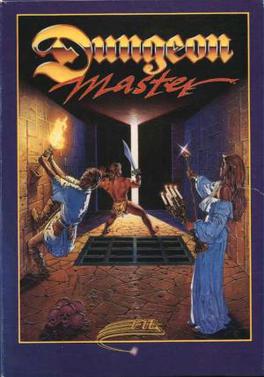
Dungeon Master is a role-playing video game featuring a pseudo-3D first-person perspective. It was developed and published by FTL Games for the Atari ST in 1987, almost identical Amiga and PC (DOS) ports following in 1988 and 1992.

Beyond Zork: The Coconut of Quendor is an interactive fiction video game written by Brian Moriarty and released by Infocom in 1987. It was one of the last games in the Zork series developed by Infocom. It signified a notable departure from the standard format of Infocom's earlier games which relied purely on text and puzzle-solving: among other features, Beyond Zork incorporated a crude on-screen map, the use of character statistics and levels, and RPG combat elements.

Greyhawk Adventures is an accessory for the Advanced Dungeons & Dragons (AD&D) World of Greyhawk campaign setting.

Uninvited is a black-and-white horror-themed point-and-click adventure game. It was originally developed for the Macintosh by ICOM Simulations and released in 1986 by Mindscape as part of the MacVenture series.

3 in Three is a 1989 metapuzzle video game designed by Cliff Johnson and published by Cinemaware and Inline Design.

Wizardry: Proving Grounds of the Mad Overlord is the first game in the Wizardry series of role-playing video games. It was developed by Andrew C. Greenberg and Robert Woodhead. In 1980, Norman Sirotek formed Sir-Tech Software and launched a beta version of the product at the 1980 Boston Computer Convention. The final version of the game was released in 1981.
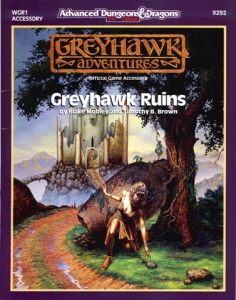
Greyhawk Ruins is an adventure module for the Dungeons & Dragons (D&D) fantasy role-playing game. It was published in 1990 by TSR, Inc. for the second edition Advanced Dungeons & Dragons rules.
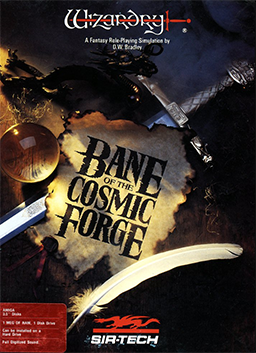
Wizardry VI: Bane of the Cosmic Forge is the 6th title in the Wizardry series of role-playing video games. It was the first in the trilogy surrounding the Dark Savant, which was followed by Wizardry VII: Crusaders of the Dark Savant and Wizardry 8. It was developed by Sir-Tech Software, Inc. and was released on the Amiga and DOS platforms in 1990 by the same company, and for the Super Famicom in Japan in 1995 by ASCII.
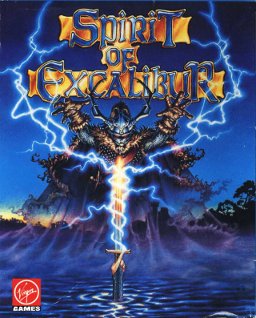
Spirit of Excalibur is a 1990 role-playing game developed by Synergistic Software and published by Virgin Mastertronic for MS-DOS, Amiga, Atari ST, Commodore CDTV, Apple IIGS and Macintosh. The player controls a host of characters with the goal of uniting Sub-Roman Britain under a single king and defending the kingdom. The game was followed by the sequel Vengeance of Excalibur in 1991.

Quest for Glory: So You Want to Be a Hero is a 1989 adventure game/role-playing game hybrid, designed by Lori Ann Cole and published by Sierra On-Line for MS-DOS. It is the first game in the Quest for Glory series, and has been credited for being a genre-defining game, as it tried to mix graphical adventure gaming with role-playing-like elements such as statistic building that would actually affect the ability to accomplish certain parts of the game. The game has a satirical and silly tone. Ports for the Amiga, Atari ST, and NEC PC-9801 were released in the early 1990s. A VGA remake, titled Quest for Glory I: So You Want to Be a Hero, was released in 1992 for DOS and later in 1994 for Mac OS.
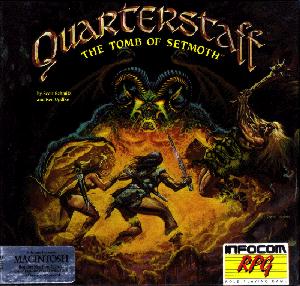
Quarterstaff: The Tomb of Setmoth is an interactive fiction role-playing video game developed by Scott Schmitz and Ken Updike and released by Infocom for Macintosh in 1988. The game features a text parser, graphics, a dynamically updated map, and a graphical interface that incorporates Mac OS hierarchical menus.

Ishido: The Way of Stones is a puzzle video game released in 1990 by Accolade and developed by Publishing International. It was designed by Michael Feinberg and programmed by Ian Gilman and Michael Sandige. The game's producer was Brad Fregger, and Brodie Lockard contributed with graphics.

Forgotten Realms Adventures is an accessory for the Forgotten Realms campaign setting for the second edition of the Advanced Dungeons & Dragons fantasy role-playing game. The book, with product code TSR 2106, was published in 1990, and was written by Jeff Grubb and Ed Greenwood, with cover art by Clyde Caldwell and interior art by Steven Fabian, Ned Dameron, Larry Elmore, Caldwell, and Jeff Easley.
Pool of Radiance is a series of role-playing video games set in the Forgotten Realms campaign settings of Dungeons & Dragons; it was the first Dungeons & Dragons video game series to be based on the Advanced Dungeons & Dragons rules.



















